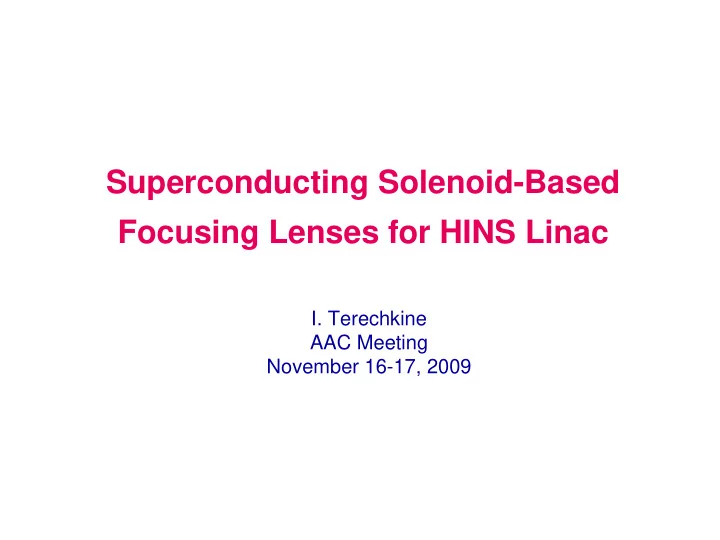

Superconducting Solenoid-Based Focusing Lenses for HINS Linac I. Terechkine AAC Meeting November 16-17, 2009
Outline • Basics of solenoid focusing, requirements, and R&D structure • RT section lens • S/C sections lenses • Cryomodule design approach • Summary Page 2 2
Why Solenoid Lens? • One focusing element provides axially symmetric focusing – important for high intensity beams. • The beam loss is governed by emittance growth and halo formation due to non-linear effects in the low energy sections ( β << 1 ), where Coulomb forces are strong. Solenoids provide smooth axially symmetric focusing that helps to limit emittance growth. Page 3 3
How it works 1. Radial component of a fringe field combined with asymmetric particle rotation provides radial component of the particle velocity; 2. Rotation in the longitudinal field results in different azimuthal position of the particles after the lens. m ⋅ ⋅ 8 T ( eV ) β 2 c m 1 q = ⋅ = β ⋅ = 2 2 Focusing length: f R 4 c 2 2 2 v q B L B L R c eff c eff Page 4
Page 5 Requirements
Page 6 Project Structure
RT Section Lens 10 MeV Solenoids (19) Cryogenic Line Chopper RT CH Section RT CH Cavities (16) V e M 5 . 2 T Buncher Cavities (2) B E M Page 7
Lens Design Removable Conduction cooled lead cover. copper lead. Helium line. Power lead 80K anchor. LN2 line for shield and HTS leads. Solenoid magnet HTS leads. with helium vessel. Instrumentation Vacuum relief. / access port. Thermal shield (80K). 18 inch (457 mm) diameter vessel. Support post. Page 8
Page 9 Lens Fabrication Corrector Assembly
Lens Performance CH SOLENOID PRODUCTION STATUS: 13 Type-1 (without Steering Dipoles): 11 tested 10 Type-2 (with Steering Dipoles): 9 tested Quality Assurance Re-testing at Fermilab First 4, then 1 of every 4: 4 T2, 3 T1 done; two tests pending Type-1 Type-2 Page 10
Page 11 Lens Testing MTF: Stand-3 MTF: Stand-6
Superconducting Section Lenses • Cold bore design • Corrector field quality • 10 -5 T fringe field • Alignment issues Pre-Production SS1-T2 Solenoid I (A) Quench Performance I = 190 A 290 270 250 MC BC 230 B-973 210 8277-2A2B 190 170 B (T) 150 5 5.5 6 6.5 7 7.5 8 Page 12
Page 13 Dipole Corrector
Fringe Field Test Focusing field at solenoid Testing new shielding center: 5 T @ 160 A material from Amuneal Requirement for field at cavity surface: <10 µT @ 225 mm Page 14
Page 15 Fringe Field Test
Alignment Requirements • Alignment requirement: +/-150 µm (with dipole correctors (B*L ~ 0.5 T-cm) and sensitive BPM) • Cryogenic environment: vacuum + low temperature • Must allow reproducible assembly on an insertion bench (clean room) and in the cryomodule • Must allow reliable measurements on the beam line Promising approach – optical alignment scheme Page 16
Optical Alignment Beam Splitter Camera Camera with Partial Mirror Partial Retroreflector Cryostat Cyrostat Window Window Solenoid Laser Pressure Vessel CCD Camera: 1 µm resolution Corner Reflector Page 17
Alignment R&D • Proof-of-principle test has been made – OK • Alignment scheme bench test in preparation • Test cryostat for SS-1 lens certification and for the alignment concept verification by comparison with other alignment methods • Prototype cryomodule with RF cavities to finalize assembly and alignment procedure. Testing with beam. Page 18
Test Cryostat Concept • Existing cavity test cryostat design • Warm bore to allow stretched wire technique • Laser-based alignment system • Modified position of the current lead assembly • Prototypes cryomodule design Page 19
Conclusion • Designs of all focusing lenses for the HINS linac have been completed (including ones with embedded dipole correctors); test methods have been developed; lens performance is well understood. • Room temperature section lenses are in the final production stage; embedded BPM feature is being implemented. • Lenses for superconducting cavity section are in the final prototyping stage (test of a pre-production lens is ongoing). • Developed fringe field measurement method can be used to verify shielding efficiency in any RF cryomodule. • Suggested alignment method is beneficial for any linear superconducting accelerator. • Testing solenoid-based transport channel is of general importance for accelerator physics. Page 20
Acknowledgments Participant List: G. Davis, C. Hess, F. Lewis, S. Sanchez, T. Wokas, Y. Huang, D. Orris, T. Page, R. Rabehl, W. Schappert, D. Sergatskov, M. Tartaglia, I. Terechkine, J. Tompkins. Support from departments: D&D, Q&M, T&I, MS, and SRF. Publication list – 52 inputs Page 21
Recommend
More recommend